Unreal Tournament 3 CPU & High End GPU Analysis: Next-Gen Gaming Explored
by Anand Lal Shimpi & Derek Wilson on October 17, 2007 3:35 AM EST- Posted in
- GPUs
High End GPU Performance
While a few titles based on the Unreal Engine 3 have already made their way onto the scene, the detail and atmosphere of Unreal Tournament 3 really show off what developers can do with this engine if they take the time to understand it. Between its first party titles and Bioshock, Epic certainly makes a solid statement that its Unreal Engine 3 is an excellent choice for leading edge graphics.
For this test, we are looking at performance scaling on high end video cards ($300+) across multiple resolutions and on multiple maps. We will absolutely be revisiting this game with midrange hardware and multiGPU configurations. In this analysis, we focus on the performance of the Suspense capture the flag map flyby. This is the most graphically intense flyby we have, and the other two maps we tested tended to exhibit similar relative performance between cards.
With our high end hardware, we've pulled out the 1920 x 1200 tests, as this is very likely to be the resolution paired with one of these parts.
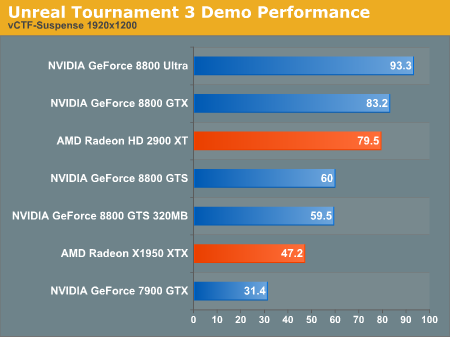
The NVIDIA GeForce 8800 GTX and Ultra both outperform the AMD Radeon HD 2900 XT, which is to be expected: the 2900 XT costs much less. But the performance gap here is not huge, and the 2900 XT gets major points for that. It handily outperforms its direct competition, the 8800 GTS (both 640MB and 320MB perform nearly identically). Not surprisingly, the X1950 XTX bests the 7900 GTX, and both of these parts perform worse than the 8800 GTS cards.
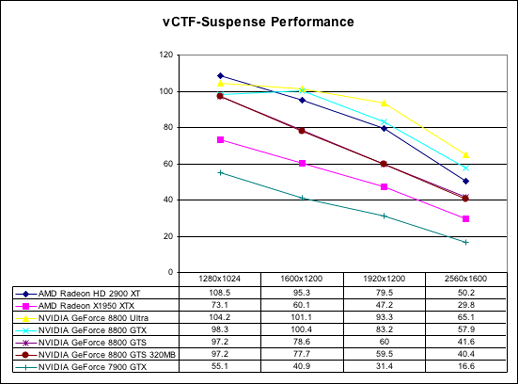
If we look at the scaling graph for Suspense, we can see that the GTS cards remain above 40fps even at 2560x1600. This is quite impressive, especially for the low memory GTS, but we do have to keep in mind that this is a flyby in a demo version of the game and we may see changes in performance between now and the final version.
Also intriguing is the fact that the high end NVIDIA hardware seems to become CPU limited at less than 1600x1200. This leads to the fact that AMD's Radeon HD 2900 XT actually outperforms the 8800 Ultra at 1280x1024. The 8800 Ultra does seem to scale very well with resolution, while the 7900 GTX drops off quickly and under performs through out the test.
While the rest of this data is very similar to what we've already presented, we did go to the trouble of running the numbers. In order to present a complete picture of what we've seen on the less demanding levels, here is the rest of our data:
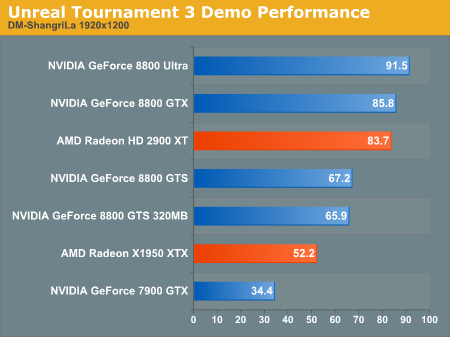
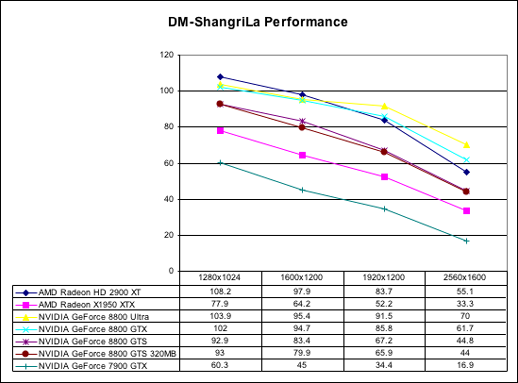
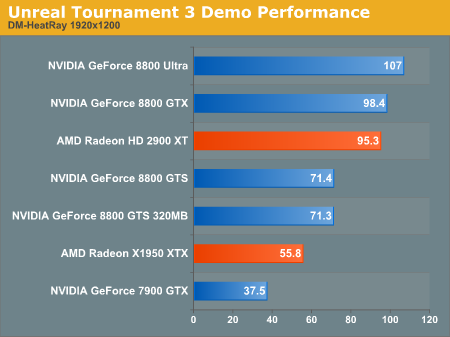
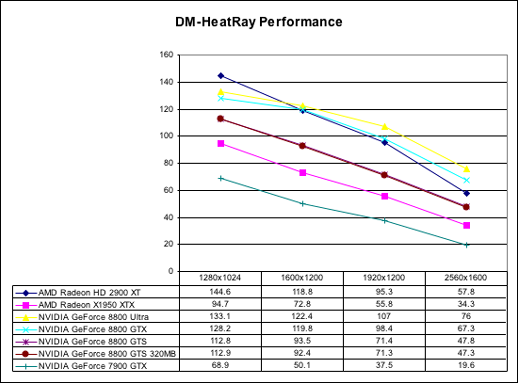
Final Words
We're just getting started with our UT3 performance analysis, but already there are some interesting conclusions to be had. Quite possibly the biggest takeaway from this comparison is the dramatic improvement in multi-threaded game development over the past couple of years. Starting from a point where none of our game benchmarks were multi-threaded just two years ago, here we are today with the latest and greatest from Epic, and seeing huge gains from one to two cores, and promising improvements when moving to four cores.
Quad-core gaming is still years away from being relevant (much less a requirement), but the industry has come a tremendous distance in an honestly very short period of time. We're more likely to have multi-threaded games these days than 64-bit versions of those titles, mostly thanks to the multi-core architecture in both the Xbox 360 and PlayStation 3. Like it or not, but much of PC gaming development is being driven by consoles, the numbers are simply higher on that side of the fence (even though the games themselves look better on this side).
On the GPU side, NVIDIA of course does quite well with the 8800 lineup, but the real surprise is how competitive AMD is with the Radeon HD 2900 XT. There may be some salvage yet for that architecture, if AMD could only bring out a midrange part that actually offered compelling performance...










72 Comments
View All Comments
decalpha - Wednesday, October 17, 2007 - link
Why not compare the CPUs with similar cache size, since Athlon 64 X2 6000 has 2MB cache whereas the Core 2 Duo E6850 has 4MB and cache size does seem to matter.drebo - Wednesday, October 17, 2007 - link
I think it's even more relevant to point out that clock-for-clock comparisons have been worthless for a very long time, and only seem to have come back on this site now that Intel has a more efficient pipeline.PrinceGaz - Wednesday, October 17, 2007 - link
The X2 6000+ actually has 2x 1MB cache, which in most cases is worse than 2MB shared, so the cache situation is even worse for AMD in the comparison that was performed.drebo - Thursday, October 18, 2007 - link
Well, cache size in general is less important for AMD processors, as the path from CPU to RAM is much, much quicker. It would be interesting (and very, very difficult to gauge) what the difference would be. This is most likely why they left AMD off of the cache comparison charts. It's impossible, due to far too dissimilar architectures, to isolate ONLY the memory subsystems, which is what a cache comparison would be attempting to do.Cache misses on an Intel architecture are far more expensive than on AMD's architecture. But, without otherwise identical chips, there's simply no way to make a comparison.
bloc - Wednesday, October 17, 2007 - link
I think if you compared the 8600 gts and x2600 xt, the perf would be pretty close, with the x2600 xt being $50 cheaper.The architecture is there. Some games like cod4 hasn't taken advantage of it yet.
ImmortalZ - Wednesday, October 17, 2007 - link
The second set of graphs on page 3 seem to be all confused. Mixed up title text?Also, regarding the ATI midrange part, surely you guys have heard about the 2900PRO?
JarredWalton - Wednesday, October 17, 2007 - link
P3 graphs fixed. I'd imagine trying to get a 2900 Pro for testing is proving more difficult than anticipated. I know looking online that the few places I've seen that list them are out of stock.ImmortalZ - Wednesday, October 17, 2007 - link
Well, it's easy to test a 2900PRO. Underclock a 2900XT to 600Mhz core and 1600Mhz memory and test away! :D (there are 512MB GDDR3 and 1GB GDDR4 versions, so...). Just change the price from 389.99 to 249.99 for the 512MB and 319.99 for the 1GB.Of course, I'd personally wait for the 2950s to show up - single slot coolers are teh win :P
Bremen7000 - Wednesday, October 17, 2007 - link
What about the page 6 graphs? Am I missing something or are they lacking something?RobberBaron - Wednesday, October 17, 2007 - link
Second that. The second set of charts on page 6 is Intel CPu's only. Little confusing